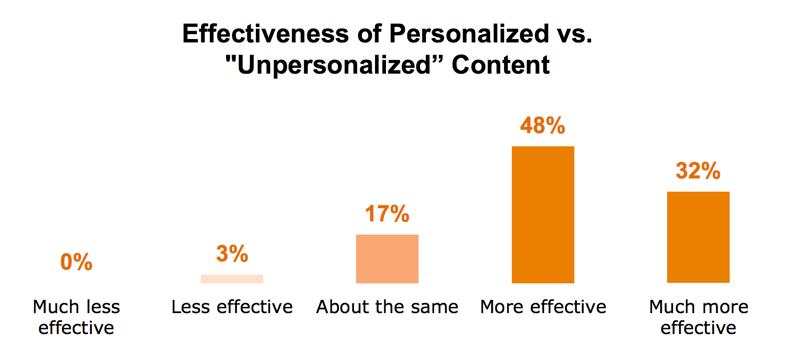There seems to be no trend bigger than that of personalization in marketing. Have you ever shopped for shoes online? I went to Zappos to look for shoes once, and found a cool pair, but didn't make the purchase. For days that pair of shoes followed me all over the internet as Zappos tried to provide consistent reminders that I needed those shoes. Personalized marketing takes something that works exceptionally well – content marketing – and makes it work even better.
Well-executed personalization in marketing takes content that was created for a general audience and has it perceived as being a personal one on one communication. Think of it this way; personalized marketing takes a formal speech, and turns it into what feels like a personal conversation.
Now adding context to marketing content is nothing new. It's been a top trend for several years now, with AdAge claiming it as the hot trend in 2014 when marketers cited personalization as "the most important capability coming to marketing".
In 2015 technology research giant Gartner got marketers hearts racing with the announcement that by 2018 companies that have “fully invested in all types of personalization” will outsell companies that have not by 20 percent.
We're still a year or two away from knowing how close to the bullseye Gartner's prediction was, but there is no denying that in 2017 personalized marketing is having a big effect on both buyers, and marketers. The reason? Personalization works for both consumers and companies.
- 86% of consumers say that personalized marketing has at least some influence on what they are purchasing and 25% say personalization significantly influences what they purchase.
- Nearly three-fourths (74%) of online consumers get frustrated with websites when content (e.g., offers, ads, promotions) appears that has nothing to do with their interests
- In a study of more than 93,000 calls-to-action (CTA's) created using HubSpot, and hundreds of millions of views over a 12-month period, HubSpot found that CTA's targeted to the user had a 42% higher view-to-submission rate than CTA's that were the same for all visitors.
80 percent of marketers say personalized content is more effective than content that hasn’t been personalized according to Demand Metric.

Sometimes personalized marketing gets too personal
Retail giant Target fought this battle recently when their marketing algorithms were able to detect that a teen girl was pregnant long before her father found out. They began a campaign of customized marketing that promoted various pregnancy products that she may need. Dad picked up some of the marketing addressed to his daughter and was understandably upset.
So how did Target "find out" she was pregnant? Target had previously discovered about 25 products that, when analyzed together, allowed them to assign each shopper a “pregnancy prediction” score. These predictive analytics are at the cutting edge of modern marketing.
So, how do marketers personalize content distribution in a way that consumers desire without crossing the "creepy" line?
6 ways you can add context to your content

1. Set up and utilize Buyer Personas.
Buyer personas are fictional, generalized representations of your ideal customer groups and you should be intimately familiar with who they are. Personas help marketing and sales to visualize and internalize "ideal customers" so you can speak to their preferences directly through content and offers. It helps to remember your personas by assigning them names. Marketing Mary or Finance Officer Fred are just a couple I've seen recently.
In order to develop the strongest buyer personas consult market research sources, as well as any insights gathered from your customer base through surveys, and interviews. The greater the detail you can provide in developing your buyer personas the easier it will be to personalize marketing for them. Depending on your size, you may only have one or two personas, or you may have a dozen.
You can now use these buyer personas to inform the strategy for the creation of personalized content campaigns each persona, treating them differently and unique.
For example, instead of sending a generic offer email to your entire list, you can customize the offer to the buyer persona. Marketing Mary is seeking the solution to a different problem than Finance Officer Fred. Segmenting by persona makes the marketing more personal, and makes the likelihood of opens and interactions increase significantly.
2. Personalize by device.
According to Google, 57% of users won't recommend a business if it has a poorly designed mobile website. If you haven't done so already, you definitely need to invest in responsive website design.
A responsive website will deliver a stellar personalized browsing experience to your mobile visitors. It will automatically adapt to different screen sizes so that the content your viewers see is tailored to their device whether it's being viewed on a tablet, smartphone, laptop or desktop.
Want to take device personalization one step further?
Let's say you have an offer that you want your visitors to download. This may not be practical on a mobile device. In addition to a direct download you may want to offer an option to email the content so that it can be downloaded later when the user is back at their laptop or desktop computer. This provides a much better user experience and it's personal to that visitor at that time. Customized marketing is as much about convenience as it is preference.
3. Use adaptive CTA's to promote content offers based on consumer behavior.
When you fire up your Netflix account they suggest a menu of shows that you are likely to be interested in based on your past viewing history. This is a great example of personalization in action. Netflix is able to do this for entertainment programs the same way that you can utilize tracking technology for your website. Cookie tracking and website analytics give you insights into your visitors interests and behaviors and can help you to serve them better content options in line with their preferences.
For example, if a visitor downloads an e-book on video marketing we know they have an interest in video. They just told us. Perhaps we could now choose to show them an intermediate level CTA with an opt-in for a video webinar on enhancing content marketing through video. Not only is this offer helpful, but it also keeps visitors moving along in the buyer journey.
Page based segmentation like this can also be a great tool for retargeting. Perhaps a lead visits your landing page for your latest webinar but didn't sign up. Why not show them a discount code to that same event to entice them to sign up?
4. Get personal in email marketing.
Email is a popular platform that many businesses choose when they get started with marketing personalization. It is definitely one of the most effective, and one of the easiest channels to personalize. Without a doubt you have seen an email come through your inbox that said "Hey (First Name)". That is personalization in its simplest form.
But there is so much more to email personalization than the first name.
You could include the name of the recipient's company, or reference a piece of content that the recipient recently downloaded. You could even personalize the sender of the email so a contact in your CRM always receives emails from the same person in your company.
5. Segment by lifecycle stages.
List segmentation is the process of categorizing your CRM contacts within your database into contact types based on similar characteristics. When you divide your database into segmented lists, it allows you to determine which type of content resonates best and allows you to disseminate that content to the appropriate recipient.
Lifecycle stages are a great place to start with list segmentation.
Some lifecycle stages that you could use to segment are lead, subscriber, marketing qualified lead, sales qualified lead and customer. But there are also many others.
Are you starting to see how a message to each of these different segments of your list can be personalized?
6. Add live chat to your website.
Adding chat to your website is another way to make your marketing more personal. What's more personal than a one on one conversation? Visitors that engage in the chat feature are also doing so at the point they are most interested in your business.
Many people don't want to fill out forms on websites and wait to be answered. This is one area where millennial preferences are molding the future of marketing.
Adding chat also creates a direct connection between a visitor and your team. It's interactive and a great chance for you to show off your team's personality and keep adding more value to the relationship. You the opportunity to show them how much value you can provide in the long term by addressing their immediate questions in the short term. It's instant personalized communication.
There you have it, six ways to begin getting personal in your marketing. Hopefully this has given you some solid food for thought around the concept. Personalized marketing is a vast topic and as an industry we have only scratched the surface. As technology makes advancements and as consumer buying patterns evolve, it is becoming more important than ever to embrace the concept of customized marketing. Get started today.




